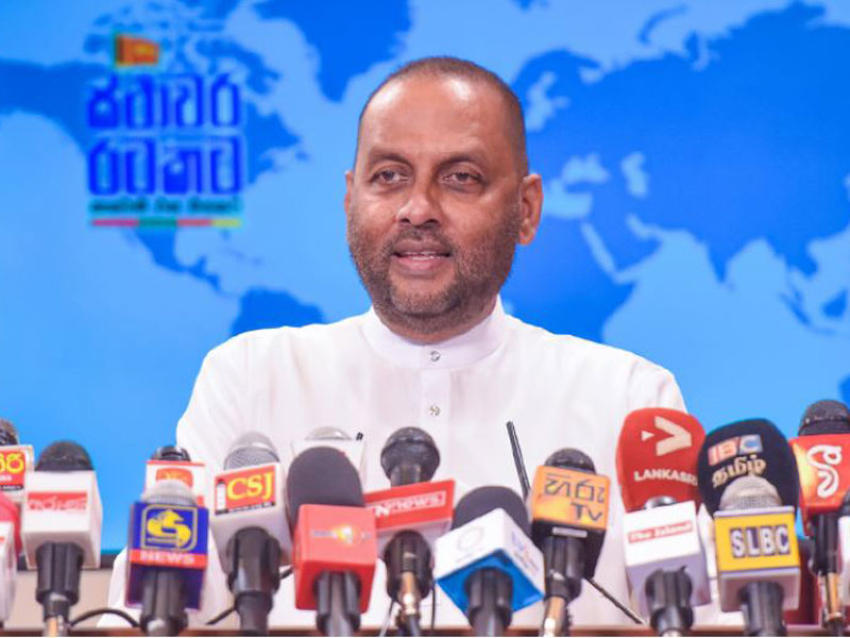He announced a new initiative to cultivate green gram (mung) in paddy fields, in conjunction with the Yala and Maha seasons, targeting a harvest of 18,828 metric tons. Under this program, each farmer will receive 25 kg of graan gram seeds per hectare.
Addressing the press briefing titled “Collective Path to a stable Country” held at the Presidential Media Centre (PMC) today (24), the minister pointed out that, following the record rice harvest in 2023, the country produced nearly 3 million metric tons of rice, resulting in a significant surplus.
The Minister also noted that the total rice production in the country stands at 4.5 million metric tons.
Minister Amaraweera further explained;
The fertilizer crisis during the Maha season of 2021 disrupted rice production, leading to insufficient rice supplies in 2022. Predictions circulated in press conferences that rice prices could exceed Rs.500 per kilo. However, under President Ranil Wickremesinghe’s leadership, the government took comprehensive measures to boost domestic rice production.
Urea fertilizer was provided for the 2022 Yala season, and farmers received a Rs.20, 000 of subsidy per hectare for paddy cultivation. As a result, the country did not need to import any rice in 2023.
In 2023, Sri Lanka’s rice production reached 4.5 million metric tons, while the annual rice requirement is 2.4 million metric tons. From the paddy harvest, nearly 3 million metric tons of rice was produced, resulting in a surplus for the year.
This surplus is attributed to farmers following our guidance.
Additionally, due to a previous shortage of maize, we allocated about 100,000 metric tons of rice for animal feed. By using rice as feed for cattle and chickens, the country significantly reduced its expenditure on maize imports.
Our objective is to double the paddy yield within the next five cropping seasons. To achieve this, we plan to introduce new agricultural technologies aimed at increasing the yield per hectare to 9 metric tons. A comprehensive technical package will be rolled out to support this goal.
We are also implementing this initiative in agricultural areas such as Anuradhapura, Ampara, Polonnaruwa, Hambantota, Monaragala, and Kandy. Additionally, the Department of Agriculture has been directed to commence cultivation for the third or intermediate season immediately following the end of the Yala season. As part of this plan, we will initiate the green gram cultivation program in paddy fields right after the 2024 Yala season concludes. So far, 4,464 hectares of green gram have been cultivated in the 2024 Yala season, with an expected production of 6,500 metric tons.
In the intermediate season, green gram will be cultivated on 8,943 hectares, with an anticipated yield of 6,707 metric tons. This contributes to a total of 13,407 hectares of green gram for the year, with a projected yield of 13,207 metric tons.
Our goal is to fulfil 75% of the annual green gram requirement during the Yala season.
The annual green gram requirement in the country is 20,000 metric tons. We are expecting to produce 18,828 metric tons by growing green gram in both the young and high seasons. For the intermediate season, we will provide 25 kg of green gram seeds per hectare free of charge, equating to Rs.25, 000 worth of seeds per hectare for each farmer.
Additionally, we plan to impose an import tax on green gram to limit imports and protect local farmers.
Furthermore, we have merged the two government-owned fertilizer companies into a single entity, which has enabled us to reduce the prices of five types of fertilizers by Rs.1, 500 to 2,000. This concession extends to fertilizers used in cinnamon, coconut, and tea cultivation.
During the past, farmers’ issues have been politicized and used to incite various agitations and protests. However, with the agricultural modernization program launched by the current government to promote local agriculture, it is no longer possible to manipulate farmers for political purposes.




















